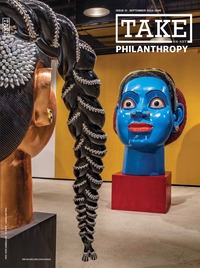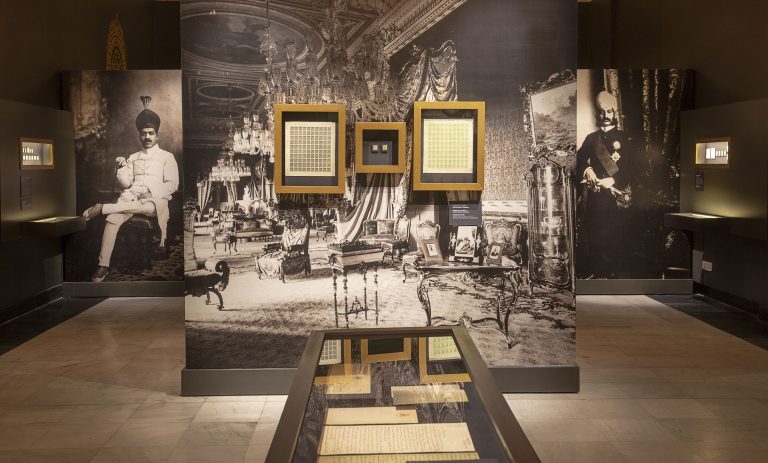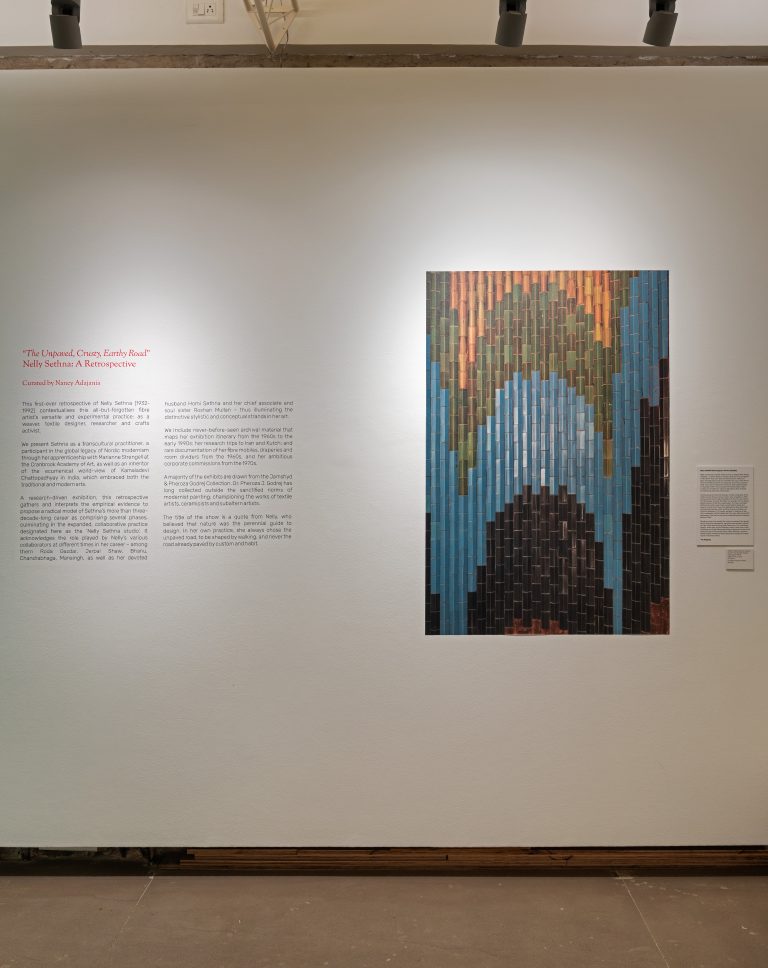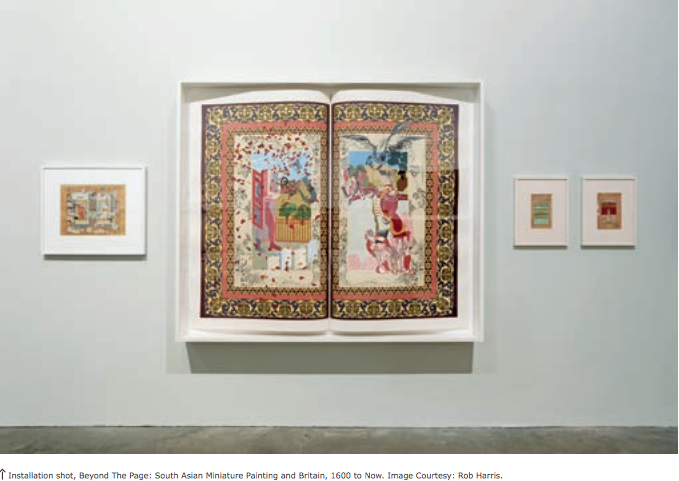
The exhibition Beyond the Page: South Asian Miniature Painting and Britain, 1600 to Now examines the traditions and legacies of South Asian miniature painting through major examples of miniatures from as early as the mid-16th century right up to the present day, with the re-engagement of modern and contemporary artists with the form. The exhibition
brings together 180 works from private and public collections across the UK and internationally. This is the first time that many of the early miniature
paintings from the Royal Collection, the Victoria & Albert Museum, and the British Museum have been on public display. The exhibition is a chance to chart the trajectories and encounters between the traditional early miniatures, and modern and contemporary reinterpretations.
The first room strongly sets the viewer up for the exhibition’s narrative, juxtaposing miniatures from the Royal Collection from the mid-17th century with modern and contemporary works. Shazia Sikander’s horizontal miniature, The Scroll, takes the vertical format of the miniatures that her work shares the exhibition space with, and allows the details that traditionally constrict the imagery and narrative of the miniature to escape the frames. Noor Ali Chagani and Imran Qureshi have collaborated on a new commission for the exhibition. Ali Chagani’s brick work creates an imagined architectural space which is spattered with Qureshi’s trademark ‘blood splats’. While Sikander’s early painting timidly steps outside the frame, Ali Chagani’s and Qureshi’s collaboration truly takes the miniature beyond the page.
The exhibition continues into a treasure trove of early miniatures, and modern and contemporary works. It tells the story of the inaccessibility of these miniature collections to artists working in South Asia; the miniatures were ‘bought’, looted, and transported in various ways to Britain. Therefore, many modern South Asian artists were introduced to the miniature through British colleagues or through studying in England. The father of the Santiniketan school, Abanindranath Tagore was introduced to Mughal paintings by the British art teacher E. B. Havell at the Calcutta School of Art. Pioneering South Asian modern artists Samuel Fyzee-Rahamin and Abdur Rahman Chugtai and the following generation, Zahoor ul Akhlaq and Gulammohamed Sheikh, all discovered traditional South Asian miniatures in UK collections during their studies in London. It is important to note that the re-adoption of the Mughal miniature for the modernists was an anti-colonial gesture, bringing forth cross-cultural approaches to critique the impact of colonial power.
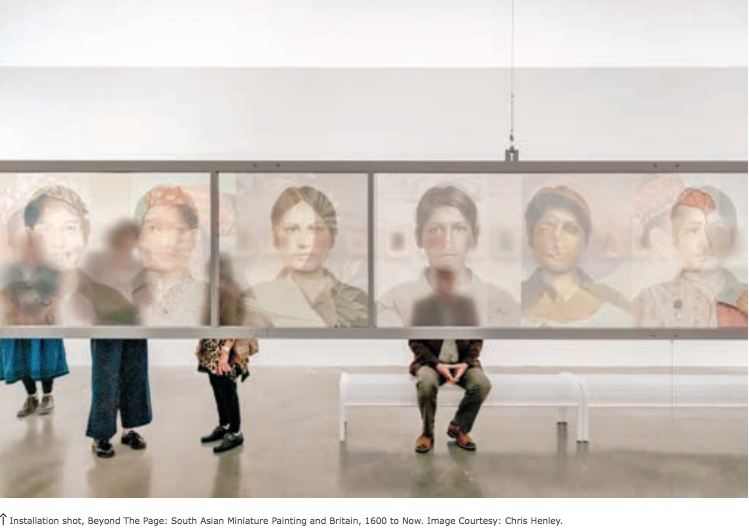
Akhlaq and Sheikh would return to South Asia as teachers and practitioners, inspiring future generations of artists to grapple with the traditional form of miniature painting at the National College of Arts in Lahore and the Faculty of Fine Arts at the Maharaja Sayajirao University in Baroda. In the fourth room, this influence of reworking the traditional miniature comes to light; it is the strongest point in the exhibition. Nusra Latif Qureshi’s digital frieze, Did You Come to Find History? takes over the central space; the digital hanging piece blurs identities between South Asia and Europe, mapping miniature portraits onto Venetian portraits from the 16th century. Hamra Abbas’ All Rights Reserved draws a line to one of the first works in the exhibition from the Royal Collection. Abbas’ digital triptych reconfigures the earlier miniature scene through cropping and removing the gifts from the hands of the figures and transferring them to the third panel; they float against a white background referring to the increasing commercialisation of contemporary South Asian art at the time. Next to this key work, Karkhana brings the traditional workshop of the royal Mughal court into the contemporary. Imran Qureshi, Aisha Khalid, Hasnat Mahood, Nusra Latif Qureshi, Talha Rathore and Saira Wasim collaborated—in a manner akin to the Surrealist ‘exquisite corpse’ game— working across five cities on three continents. The six artists collaboratively produced twelve miniatures, which were shared via FedEx; the artists mimicked each other’s styles and played with imagery with comical political overtones in the aftermath of the 9/11 attacks. Several other contemporary works—by Ali Kazim, Muhammad Zeeshan and other artists—in this room are placed in dialogue with their source material. This exhibition really plays to its strengths in terms of loans from both private and public collections. It presents a unique opportunity to view these contemporary works alongside the Mughal source materials.
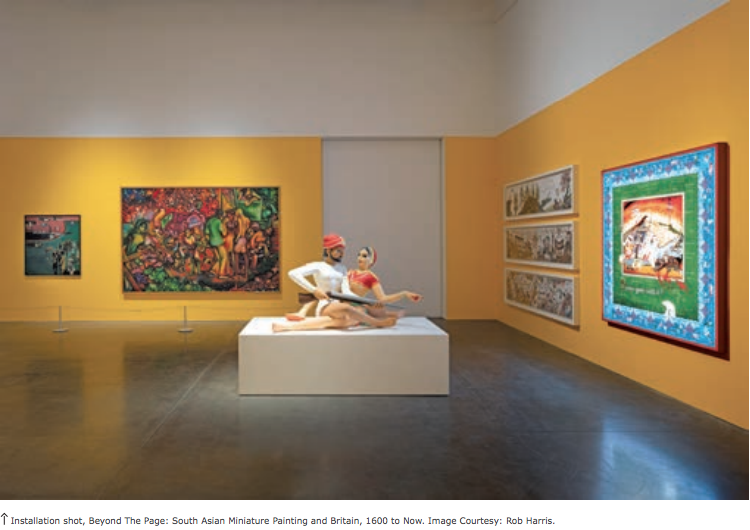
While the visual connections and immense detail of the early Mughal miniatures keep you captivated throughout most of the rooms, the final two rooms feel slightly less convincing. Although the pieces—by Nilima Sheikh, Hamra Abbas, and the Singh Twins— draw connections to earlier miniatures, the shocking yellow wall-colour and contrasting works by Raqib Shaw and Gulam Mohammed Sheikh, among others, appeared slightly too far from the traditional form of the miniature, and the rhythm of the exhibition starts to lose its momentum. However, the natural history illustrations from the UK collections are a pleasant surprise in the final room. The earlier works tell the story of the East India Company’s involvement in India: The Company created a botanical garden in Kolkata to experiment with lucrative plants, and Dr. William Roxburgh commissioned Indian artists to illustrate his detailed descriptions. The narrative emphasises the western influence on Indian artists’ depictions of the natural world, but it would have added to the wider exhibition’s message if the interpretation texts had drawn a South Asian lineage to the flora and fauna of the borders in Mughal miniatures. Beyond the Page is an enjoyable game of spotthe-difference and an art historian’s playground. The non-chronological order successfully subverts the viewer’s expectation of temporal influence. From the 16th century watercolours depicting the life of Mahavira, to contemporary works by Imran Qureshi, Shazia Sikander and Ali Kazim, the traditional form meanders, and weaves through the exhibition. Nonetheless, the treasure trove of loans and commissions is also slightly overwhelming; the walls are covered almost completely by the works, and the perambulatory space is taken over by vitrines, which makes the show rather exhausting to take in with only one visit. However, the gallery is just thirty minutes from London, so it is an easy decision to make a second trip to truly appreciate the intricate details of the Mughal miniatures and their contemporary reimaginings.
Beyond the Page: South Asian Miniature Painting and Britain, 1600 to Now, curated by Hammad Nasar and Anthony Spira, with advice from Emily Hannam, MK Gallery, London, 7 October 2023 – 28 January 2024.











